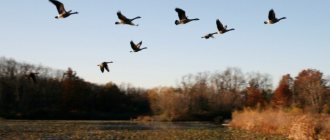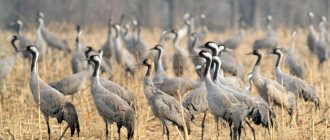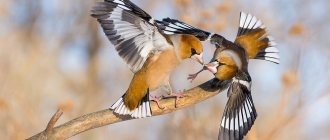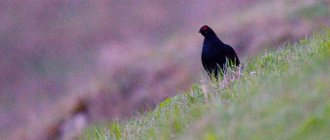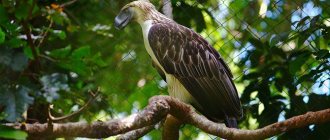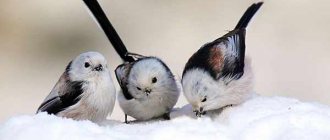Even at school, we were told that in cold times birds leave our region, flying to where it is warm. But where exactly do birds fly from Russia for the winter? According to many people, they go to a warm region because they are cold here. As it turned out, this opinion is wrong. Many birds have a dense cushion of down under their feathers, which serves as an excellent “warmer” at sub-zero temperatures. The main reason that they fly to other places is the lack of food. In winter, there are no many insects, as well as berries, which are included in the diet of birds. Before flying away, the birds rest in flocks and gain strength. Those who fly to warmer climes are considered migratory. But there are also individuals that can easily tolerate the cold - we are talking about sedentary birds. They easily cope with the search for food even in winter.
Migratory individuals fly away in different ways: some fly in flocks, while others fly alone. For example, a crane or wild goose forms a wedge - in appearance it resembles a triangle figure. Looks very nice. The places where birds will winter are very different. The weather promotes accelerated departure or, conversely, delays it. If it is warm and sunny, the birds will not rush to leave their home. Otherwise, their departure will accelerate.
Migratory birds
Birds are warm-blooded creatures. Their body temperature is forty-one degrees. Thanks to this, they would feel great on frosty days. So why do migratory birds fly away? Birds cannot stay over the winter because during the cold seasons it is almost impossible for them to get food. Some fly away due to the cold weather. They migrate to warm regions to preserve most of the individuals.
Migratory birds, that is, those who leave our area in winter and fly south, include many species of birds. These include lapwing and swallow, wagtail and chaffinch, robin and song thrush, oriole and redstart, tree pipit and lark, and chiffchaff.
Banding method: what it is, who does it and why
To find out where birds migrate, how long they fly, what their life expectancy is, and where a particular species nests, scientists use the ringing method.
This is a way to count birds. The bird is caught and a metal ring with a specific code, information about the country and the organization involved in the research is placed on its paw.
What kind of ring could it be?
Bird ringing rings are made from aluminum or stainless steel. This method takes into account what species the individual belongs to - migratory or wintering. In cold weather, a stainless steel ring can cause discomfort to the bird.
The method of ringing birds is inconvenient, because in order to read the code on a metal passport, the winged individual must be caught again. Scientists have recently developed a color banding system. Birds caught and ringed in 2009 wear purple rings, those caught in 2010 wear orange rings, and so on.
This method helps you see birds from afar and even make out information from the ring in a photo taken from the ground. Multi-colored rings are made of plastic.
Bird ringing is carried out at special ringing stations.
This is a facility where scientists, ornithologists, volunteers work - people interested in counting birds. If several decades ago, birds were caught one by one and banded, today there is mass catching and large-scale banding. Ornithologists can use large traps and nets to capture entire flocks of birds.
The ringing method proved that not all migratory birds fly south. Most move to the west or southwest for the winter.
Why do bird ringing stations work?
The work of bird ringing stations helps to learn new information about the life of winged birds.
Why are rings put on the paws of pigeons and parrots?
Sometimes you can see a pigeon with a ring on its foot. The bird is not migratory, then why is pigeon ringing used by ornithologists?
Those pigeons that are bred are ringed. After birth, a ring is placed on their paw indicating the date of birth, information about the parents, the color of the plumage, and so on.
Those who breed parrots also band them. Banding budgerigars is a kind of birth certificate. If the parrot flies away or gets lost, based on the data on the ring, it will be possible to determine whose bird it is. The ring is put on when the budgie is 6-7 days old; it can be removable.
Ringing a parrot is convenient when purchasing a bird at a pet store. Using the data on the ring, you can find out information about the age, parents, and place of birth of the individual.
It is important to remember that birds need human help. It is especially necessary for those birds that do not fly to warm countries, but remain to spend the winter.
When and how do birds fly away?
The moment when birds leave our region can be influenced by the weather. However, as a rule, this happens at the same time. The autumn flight begins only when the young birds become stronger.
Most birds gather in flocks. But there are also those who fly in groups. Some species fly away alone.
The cranes line up in a beautiful wedge in the sky. But crows are usually placed in a chain. There are species of birds in which the males fly away later than the females. In some birds, the young immediately leave the inhabited area. Older individuals follow them after some time.
Birds try to move during the day and rest at night. For some species, migration time is night.
Thailand
Holidays at the resorts of Thailand are the best medicine for the winter blues. Some people love the coconut beaches of Koh Samui for their zen atmosphere, soft sand and sea with a temperature like in a home bath. Others appreciate eccentric Pattaya for its exotic beach bars and cheap shopping.
But both of them confess their love for beautiful Phuket: there is overflowing fun in the bars of Patong, and romantic sunsets on the secluded Freedom Beach.
- Current rules for entry into Thailand
Resident birds
Not all representatives of the feathered world leave their inhabited areas. Some stay for the winter and delight us with their songs on frosty days. They live in their homeland all year round, which is why they are called sedentary. The capercaillie does not leave its place. He eats pine needles and therefore does not have to look for food in winter. Juniper berries are eaten by hazel grouse and grouse. They are also not going to fly anywhere in the fall. But is the jay a migratory bird or not? This species of birds is sedentary. The jay eats plant and animal food. She loves acorns. With its beak the bird easily splits the shell of these oak fruits. In autumn, jays store acorns in huge quantities. One bird, according to some sources, makes reserves weighing up to four kilograms.
Woodpeckers and titmice also belong to the sedentary species. But the crossbill even hatches chicks in winter. At the same time, it feeds on spruce seeds.
Where do birds go for the winter? Funny myths from the past
Just some 200 years ago, people could not even imagine that birds would travel thousands of kilometers to spend the winter in warmth and comfort.
What kind of inventions did ornithology (the science of birds) know? Aristotle himself believed that many birds, including swallows and kites, hibernate during the winter, and some even transform into another species. According to the philosopher, the redstart, which he observed only in the summer, in the fall turns into a robin, which the scientist had to see only in the winter.
Many scientists listened to the fantastic versions of Aristotle, who lived before our era. Even a couple of centuries ago, they were sure that swallows and swifts hibernate at the bottom of lakes, immersed in silt. There were also those who considered the birds too fragile to cross seas and oceans, so they “sent” them to the moon to spend the winter! Europeans and North Americans believed that small birds traveled on the backs of large ones.
Why do birds fly away
The cuckoos are the first to leave our region. Behind them are swallows, and a little later - swifts. From late August to September, several species change to a warmer climate.
What are the reasons for bird migration? Birds fly away with the onset of cold weather. However, the main reason for their migration is not the change of season. The decisive factor is the lack of food. Thus, a cuckoo eats up to a hundred caterpillars in one hour, and during cold weather the insects disappear. Most of them die, leaving a large supply of eggs from which offspring will hatch in the spring. Some insects hide in secluded warm places.
In summer the stork feeds on small fish and frogs. In winter, he is not able to get food for himself, which is under the crust of ice covering the reservoirs. Birds that cannot get food for themselves fly south. They don't have any problems with food there.
Whooper swans
These majestic and beautiful birds nest in vast areas from the tundra to the mountains of Southern Siberia, choosing lakes rich in food. For wintering, whooper swans also choose a region closer to the main nesting site. The inhabitants of European Russia fly to the Black Sea, Turkey, Romania and Bulgaria. Whooper swans from Western Siberia prefer to winter in the Caspian Sea, Iran and Azerbaijan, and birds from Eastern Siberia and the Far East fly to China, Korea and Japan.
Annual cycle of birds
The life of birds, as well as other animals, on most of our planet is subject to changing seasons. The only exceptions are those areas where tropical forests are located.
The annual cycle of birds consists of four main stages. The first of these is the breeding season. Then comes molting, the seasonal migration of birds. The last stage is wintering.
As for seasonal migrations, they are not a continuous period for birds. There are flights in spring and autumn. At the same time, they are separated from each other by the wintering stage. The spring migration of birds can be considered as a phenomenon that is partially associated with preparation for the breeding stage. Autumn migrations are a search for food to preserve the species.
Kostroma: the birthplace of the Snow Maiden
Soft frost, a forest covered with a blanket of fluffy snow, ancient buildings and monasteries - this is exactly what a winter holiday in Kostroma will be like. The cozy town is ideal for traveling for a few days during the New Year holidays or for a weekend.
The Ipatiev Monastery played a big role in ending the Great Troubles. Photo: commons.wikimedia.org
Stroll along the streets, admiring the old merchant houses, taste Kostroma cheese, and stop by a jewelry store - locally made jewelry is sold here. Head beyond the city to the majestic Ipatiev Monastery, the cradle of the Romanov dynasty. And be sure to visit the tower of the Snow Maiden, who lives in Kostroma separately from her famous relative. Like Santa Claus, his granddaughter opens the doors of her mansion to everyone: take a walk through her house, be sure to look into the ice room, try a snow cocktail.
You can plunge into a Russian fairy tale by visiting the Snow Maiden. Photo: teremsnegurochki.ru
average temperature
| December | -5…-10 |
| In January | -7…-13 |
| In February | -5…-12 |
How to get there
| By plane, train or bus from Moscow and nearby cities. |
Prices
| Train ticket | From 800 rub. one way |
| Hotel accommodation | From 1100 rub./day |
| Tickets to the Snow Maiden's tower | 200–300 rub./person. |
* Prices are for 2022.
During the New Year holidays prices may be higher. FIND OUT MORE
Where to go for the New Year: the best travel ideas
The closer the New Year holidays are, the more acute the question of how to spend the long holidays interestingly and usefully.
Fairs, slides, skating rinks, cultural programs and incredible nature - everything bright, cheerful, sparkling in full in different cities of Russia. There is a lot of choice, and the long Christmas holidays can be divided into two parts and take several trips at once. We have collected the best places that you will definitely remember. View routes
Migration routes
Where do birds fly in the fall? Ornithologists were able to answer this question in detail. By banding migratory individuals, they established wintering sites for various species. To which warm regions do birds fly? The suitability of a particular area for wintering is determined, of course, by its ecological situation. However, birds do not always fly to places that are located close to their nesting and have favorable conditions. To a greater extent, competition with other populations of a similar species, which strive to occupy the most convenient wintering areas, plays a role here. Thus, birds arriving from areas further north may be located in more southern latitudes.
From Europe, birds can fly not only in a southern direction. They also winter in the west. England gives shelter to many northern and central European birds. This country has favorable climatic conditions for birds, which are characterized by light snowfalls and mild winters. Lapwings and sparrows, woodcocks and other birds fly to England in the fall. However, more birds are attracted to the Mediterranean and southwestern regions of Europe.
How long does the flight take?
The duration of the flight is affected by the speed and distance to the wintering site. Birds fly at different speeds. For example, swallows reach speeds of up to 55-60 km/h, finches and siskins - 55 km/h, waders on average up to 90 km/h. Birds fly intermittently as they stop to rest and feed; stops can last from one to ten days. Therefore, the flight for some birds takes up to four months. For example, passerines spend two to three months migrating from northern Europe to Central Africa. The duration of the flight is significantly affected by weather conditions.
Wintering places
To which warm regions do birds fly? A large concentration of birds is observed in winter in the Nile Valley. Some Arctic and Siberian birds fly to their African wintering grounds. Their numerous flocks are also located in the southern regions of China, India, and the islands of the Indo-Australian archipelago. Quails and waterfowl fly to northern Africa and Western Europe. The path of some bird species to wintering areas is very far. Thus, Icelandic sandpipers and East Siberian anemones reach the shores of New Zealand.
Research by ornithologists helps answer the question of where birds fly for the winter. Thus, by banding the birds, they established that our blackbirds and starlings rest in the south of France and Portugal. They settle in Spain and Italy. Ducks and cranes love to travel to the banks of the Nile. Hoopoes and nightingales winter in the African savannah.
Some species of waterfowl do not leave the territory of Russia. In cold seasons, they settle in reserves located in the Southern Caspian Sea. Mallard ducks can be found in winter in Transcaucasia. They rest on the Azov and Black Seas.
To what warm regions do birds living in the north of the American continent fly? Here their migration, due to the influence of the Gulf Stream, goes only in a southerly direction. Thus, Arctic terns, which live in the north of America, settle for the winter in the south of the continent. Sometimes these birds migrate to African countries. They also end up in Antarctica.
Airspeed
The flight speed of birds during migration is relatively low. One of the slowest is the quail - it flies at a speed of approximately 40 km/h ; the black swift is among the fastest (160 km/h). But during the flight, birds can spend a lot of time on stops, and in general, their long journeys - for example, to Africa - can last for 2 - 4 months. The speed of spring migration when migrating species return is higher - in spring birds return home faster than in winter they fly to wintering grounds.
What wintering sites do birds choose?
As a rule, birds settle where the habitat is similar to that in which they live in their homeland. If birds choose forests for their nesting, then these are the areas they will look for in areas with a warm climate. Birds living in steppes, meadows or fields will look for familiar conditions for settlement. This will allow you to find their usual food. Thus, the birds fly away to those regions where living conditions differ little from what they are used to.
They find their way to wintering places thanks to a superbly developed navigation system. For some birds, major landmarks are mountains, sea coasts, and so on. There are species that calmly cross the water surfaces of the ocean that are not very diverse.
Those species of birds that fly during the day are guided by the sun. Those birds that travel in the dark rely only on their own navigation system.
The winter cold will recede, and the birds that have flown to warmer climes will return home again. They will announce the arrival of spring with cheerful trills and will prepare for the next stage of their lives.
Now you know to which warm regions birds fly. Good luck in your further study of birds!
Irkutsk: the heart of Siberia
Every Russian should go to Siberia at least once in winter - to feel those same Siberian frosts and see a real winter: harsh and beautiful at the same time. The capital of Siberia, Irkutsk, is an ideal city for such a trip.
The historical center of Irkutsk looks truly fabulous in winter. Photo: Yulia PYKHALOVA
Modern and developed, Irkutsk, however, breathes history. The appearance of the city surprisingly combines buildings of the 19th century, ancient churches and monasteries, wooden towers with carved platbands, Soviet high-rise buildings and modern skyscrapers. A city of complex destinies and eras, Irkutsk offers guests many museums and other attractions, among which any traveler will find something interesting.
Many tourists come to Baikal in winter to walk on the ice. Photo: Elena KRIVIAKINA
And it’s also a stone’s throw from Irkutsk to Baikal - in winter the lake freezes, becoming covered with transparent ice. At this time of year it is almost busier than in summer: you can visit one of the many festivals, ice skate on frozen Baikal, take a steam bath or celebrate Sagaalgan - the Buddhist New Year.
average temperature
| December | -10…-19 |
| In January | -13…-22 |
| In February | -8…-20 |
How to get there
| From Moscow by plane (about 4-5 hours) or by train (3.5 days). |
Prices
| Flights Moscow - Irkutsk - Moscow | From 10,000 rub./person. |
| Train Moscow - Irkutsk | From 7400 rub./person. one way |
| Hotel accommodation | From 1200 rub./day |
| Museum tickets | From 100 rub./person. |
| One-day excursion to Lake Baikal | From 7000 rub. |
* Prices are for 2022. During the New Year holidays prices may be higher.
White storks
These birds live in Europe and the eastern part of their range is located in European Russia. These large birds are not exactly lovers of an easy life, because they fly to South-East Africa for the winter, making them one of the most prominent migrant travelers. Some birds settle in Ethiopia, Kenya and Tanzania, the rest fly to South Africa and Namibia.


